| |
Factors Associated with Acquisition and Clearance of Human Papillomavirus Infection in a Cohort of US Men: A Prospective Study
|
| |
| |
The Journal of Infectious Diseases Feb 1 2009;199:362-371
Beibei Lu,1,2 Yougui Wu,2 Carrie M. Nielson,3 Roberto Flores,1 Martha Abrahamsen,1 Mary Papenfuss,1 Robin B. Harris,4 and Anna R. Giuliano1,2
1H. Lee Moffitt Cancer Center and Research Institute, 2Department of Epidemiology and Biostatistics, College of Public Health, University of South Florida, Tampa; 3Oregon Health and Science University, Portland; 4Arizona Cancer Center and Mel and Enid Zuckerman College of Public Health, University of Arizona, Tucson
"Approximately 25% of men reported 4 or fewer lifetime sex partners, and about 25% reported >16 partners. Only 20.7% of men reported consistent use of condoms during sexual intercourse, and 41.0% reported never having used condoms."
ABSTRACT
Background. Our understanding of factors associated with acquisition and clearance of human papillomavirus (HPV) in men has been limited. This study sought to determine factors associated with those aspects of HPV infection in a cohort of US men.
Methods. A total of 285 men aged 18-44 years were monitored every 6 months for 18 months. Risk-factor information was obtained at each visit by use of a self-administered questionnaire. A continuous-time 2-state Markov model was applied.
Results. Lifetime number of sex partners reported at enrollment was the most significant risk factor for acquisition of all types of HPV. Men reporting >16 lifetime sex partners were at significantly elevated risk of any HPV infection (adjusted hazard ratio [AHR], 2.8 [95% confidence interval {CI}, 1.1-7.1]), oncogenic HPV infection (AHR, 9.6 [95% CI, 2.4-37.8]), and nononcogenic HPV infection (AHR, 3.6 [95% CI, 1.3-9.9]), compared with those reporting 0-4 partners. Circumcised men were 3 and 6 times more likely to clear infection with any and oncogenic HPV types, respectively. In addition, having had >16 lifetime sex partners was associated with greater likelihood of clearance of oncogenic HPV infection (AHR, 4.9 [95% CI, 1.2-19.8]).
Conclusion. The key factor associated with acquisition of HPV was lifetime number of sex partners, whereas circumcision was the most significant determinant for clearance of any HPV infection and oncogenic HPV infection.
Human papillomavirus (HPV) infection in men contributes significantly to infection and subsequent cervical disease in women [1-4]. Studies of HPV infection in heterosexual couples have shown that males' sexual behavior and HPV infection status are significantly associated with their female partners' risk of precancerous lesion and cervical cancer [1-7]. High prevalence and high incidence of genital HPV infection in men are also associated with anal and penile lesions [8-10] and with cancer of the anal canal and penis [11-15], especially in immunocompromised men [16, 17].
Prevalence and incidence of HPV appear to be high in men. In a report by Dunne et al., in which HPV prevalence in men was systematically reviewed, prevalences of HPV were 1.8%-72.9% [18]. Several recent prevalence studies that evaluated a full spectrum of HPV types in a variety of male populations, including steady sex partners of HPV-positive women [19], patients at sexually transmitted infection (STI) clinics [20], male university students [21], and community residents [22, 23], observed prevalences of 16.5%-51.5%, depending on the anatomic sites evaluated for the presence of HPV infection. In 2 recently published prospective studies of US men, 62.4% of 18-20-year-old male university students who had no detectable HPV infection at enrollment acquired HPV at least once during a 24-month period, and 29.2% of 18-44-year-old men acquired HPV during a 12-month period [24, 25].
Factors associated with detection of HPV in men have been evaluated in cross-sectional studies that included men attending vasectomy clinics [26] or STI clinics [27, 28], male university students [29], and community residents [30]. Lifetime number of sex partners [28, 30], number of recent sex partners [28, 30], circumcision status [26-28], age at first sexual intercourse [29], condom use [27, 30], smoking status [26, 30], sexual frequency [27], and the presence of genital warts [27] were significantly associated with prevalent HPV infection. Few natural-history studies of HPV infection in men have been published [24, 25, 31, 32]. In published prospective studies, the number of recent sex partners has emerged as the most important risk factor for acquisition of HPV [24, 31]. Other factors significantly associated with HPV infection in men have included socioeconomic status [32], smoking status [24], age (<20 vs. >20 years) [31], condom use [31], and insertive anal sex [32]. Only 2 studies have evaluated factors associated with HPV persistence in men; in 1 of these studies, circumcision was protective against HPV persistence [32]; in the other study, the presence of multiple HPV infections was associated with increased risk of persistent infection [31]. The present study was designed to identify factors associated with acquisition and clearance of HPV infection in a cohort of 18-44-year-old US men and to compare the risk profiles of oncogenic versus nononcogenic HPV infection.
Discussion
To our knowledge, this is the first community-based natural-history study of HPV in men that has investigated and compared the determinants of acquisition and clearance of HPV infections of different oncogenic potentials. We found that the lifetime number of sex partners reported at enrollment was the most significant factor for acquisition of all categories of HPV (any, oncogenic, and nononcogenic). Circumcision was most strongly associated with clearance of any HPV infection and with clearance of oncogenic HPV infection, and lifetime number of sex partners also appeared to play a role in clearance of oncogenic HPV infection.
Our finding that acquisition of HPV is independently associated with lifetime number of sex partners is consistent with results from published cross-sectional, case-control, and prospective studies [24, 26, 28, 31, 32, 36]. In a pooled analysis of case-control studies conducted by the International Agency for Research on Cancer in 5 countries [36], the authors, Franceschi et al., examined factors associated with penile HPV DNA status in 1143 husbands of women with and without cervical carcinoma and reported that, after adjustment for country, age, and wives' case/control status, there was both a significantly higher risk of penile HPV infection (adjusted odds ratio, 2.3 [95% CI, 1.1-4.6]) in husbands who reported >51 lifetime sex partners and a significant trend of increasing risk with increasing lifetime number of sex partners [36]. Similar results (p<.001) were reported by Vaccarella et al. in their study of 779 men who visited vasectomy clinics nationwide in Mexico [26]. When risks of oncogenic and nononcogenic HPV infection were separately assessed by Svare et al., the lifetime number of sex partners was significantly associated with the prevalence of oncogenic HPV infection [28].
A small number of prospective studies of men have evaluated factors associated with acquisition of HPV [24, 31, 32]. Both Kjaer et al. [31] and Partridge et al. [24] identified the number of sex partners between follow-up visits as being the most significant risk factor for acquisition of HPV; in addition, Kjaer et al. reported that condom use (always/occasionally vs. never) had a protective effect and that younger age (<21 years) was associated with increased risk of acquisition of HPV, and Partridge et al. reported that current cigarette smoking was a significant risk factor for HPV acquisition. Insertive anal intercourse with men was reported by Lajous et al. as being the only risk factor associated with acquisition of HPV [32]. In the present study, lifetime number of sex partners was the only risk factor that was statistically significant and positively associated with acquisition of all types of HPV infection. These findings suggest that, despite the differences in study population, follow-up interval, method of risk-factor data collection, HPV DNA sampling method, underlying age distribution, and sample size, the determinants of HPV acquisition have consistently centered on male sexual-behavior factors.
Few published studies have examined the determinants of clearance or persistence of HPV [31-32]. In the present study, circumcision was a factor strongly protective against persistence of HPV. This finding is in agreement with several published studies of HPV in men [6, 19, 26, 27]. The reduction in risk of HPV infection among circumcised men in these studies ranges from about 60% to about 80% [6, 26, 27]; however, limited by the cross-sectional design, it is not known whether the risk reduction observed in these studies was the result of decreased acquisition, decreased persistence, or an interaction of both. In the present study, clinically confirmed circumcision conferred 70% and 85% reductions in the risk of persistent infection with any HPV and with oncogenic HPV, respectively, but it did not appear to confer reduction in the risk of persistent infection with nononcogenic HPV. In a study of HPV in Mexican soldiers, Lajous et al. found a similar reduction in the risk of persistent infection with any HPV (AHR, 0.12 [95% CI, 0-0.87]) [32]. Little is known about the mechanisms by which circumcision may protect against persistence of HPV, although several possible explanations have been suggested [6, 37, 38], such as improved penile hygiene and keratinization of the epithelium of the glans penis of circumcised men, which may confer resistance to abrasion from sexual intercourse. As a result, circumcised men may be less susceptible to viral entry via epithelial abrasions, subsequent viral shedding, and viral persistence.
The present study also identified lifetime number of sex partners as a strong determinant of clearance of oncogenic HPV infection in men: men with a large (>16) lifetime number of sex partners were about 5 times more likely to clear oncogenic HPV infection. It has been suggested that the increase in sexual exposure to genital HPV infection over time, as indicated by lifetime number of sex partners, may be associated with strengthened humoral response to the infection [39-42]; men with a greater lifetime number of sex partners may be more likely to mount a detectable antibody response, similar to what has been observed in studies of seroprevalence of HPV in women [43-45].
In a previous cross-sectional study conducted by our group, we observed that current smoking of >10 cigarettes/day is associated with an increased risk of HPV detection in men [30]. In the present study, we did not find an association between cigarette smoking and either the incidence or the persistence of HPV in men. The differences in results found across studies may be due to differences in the genital sites studied. The study by Nielson et al. [30] included perianal and anal-canal infection in the analysis of risk, whereas the present study evaluated only infections of the exterior of the penis and scrotum. More research that evaluates HPV infection at a variety of anatomic sites is necessary to further our understanding of the association between cigarette smoking and HPV infections in men.
A strength of the present study is its longitudinal design, which allowed repeated assessment of the sexual behavior and HPV DNA status of the participants, as well as more-accurate evaluation of associations between these sexual behavioral factors and acquisition and clearance of HPV infection over time. However, several limitations of the present study have to be discussed. One of its major limitations is the relatively small sample size and the resultant lower statistical power in detecting potential risk factors, especially for individual types of HPV infection, such as HPV 16 infection or HPV 18 infection, and in detecting factors with overweighted subgroups, such as circumcision status, in which 87.7% (250) of men were circumcised and only 12.3% (35) were uncircumcised. A second limitation is that the use of a 6-month interval between study visits is likely to result in an underestimation of HPV acquisition and clearance, because infections that might be acquired and cleared between 2 study visits cannot be known. Another limitation of the study is that, because of the asymptomatic nature of most HPV infections, the actual date when an infection is acquired or cleared is often unknown. In the present study, an infection was assumed to be acquired or cleared on the date of the study visit when testing for HPV DNA was performed. Hence, the exact time sequence of sexual behaviors of interest and outcome events remains unclear. Finally, although we attempted to include a representative sample of the general male population residing in Tucson, it is possible that younger, more-educated and informed men were included in the present study; our results therefore may not be generalizable to older, less-educated populations.
In conclusion, the key factor associated with acquisition of HPV infection of all types in the present study was lifetime number of sex partners, whereas the most important determinant of clearance of any HPV infection and of clearance of oncogenic HPV infection was circumcision; no factor was significantly associated with clearance of nononcogenic HPV infection. Future prospective studies that include a more diverse population and a larger sample size with a longer follow-up are necessary to address the limitations of the present study and to confirm the associations observed.
Results
The median duration of follow-up was 15.5 months (range, 3.7-24.7 months), and the median interval between study visits was 5.3 months. Overall, 45 men (15.8%) contributed 2 study visits each, 87 men (30.5%) contributed 3 visits each, and 153 men (53.7%) contributed 4 visits each.
As reported in a previous publication by our group [25], the estimated 12-month cumulative incidence in this cohort was 29.2%, 19.0%, and 16.0% for any HPV infection, oncogenic HPV infection, and nononcogenic HPV infection, respectively. The estimated median time to clearance (defined as the time necessary for 50% of infections to be cleared) was 5.9, 5.8, and 6.0 months for any HPV infection, oncogenic HPV infection, and nononcogenic HPV infection, respectively. The 12-month cumulative incidence was estimated to be 3.4% and 5.1% for HPV 6/11 and HPV 16/18, respectively, and the median time to clearance was estimated to be 5.4 and 6.0 months, respectively.
The characteristics of the study cohort are presented in table. 1 . The mean age of the men was 29.8 years (SD, 8.1 years), and the mean age at first sexual intercourse was 16.9 years (SD, 3.3 years). The majority of men were single or never married (63.9%), had a college education or more (75.8%), were circumcised (87.7%), reported no history of STI (73.7%), and reported having had no new sex partner during the preceding 3 months (63.7%). At enrollment, 31% were cigarette smokers, and 25.0% were former cigarette smokers. Approximately 25% of men reported 4 or fewer lifetime sex partners, and about 25% reported >16 partners. Only 20.7% of men reported consistent use of condoms during sexual intercourse, and 41.0% reported never having used condoms.
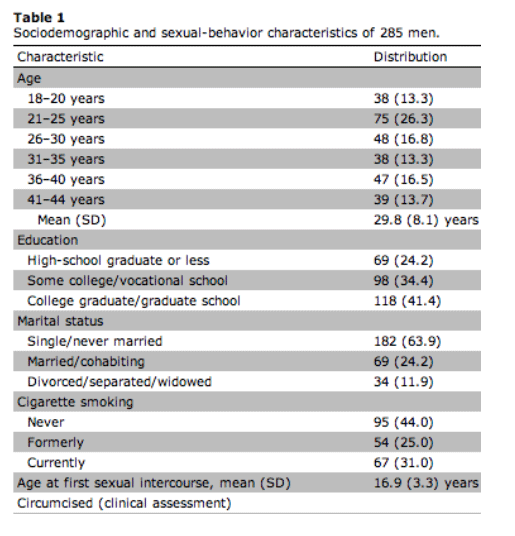
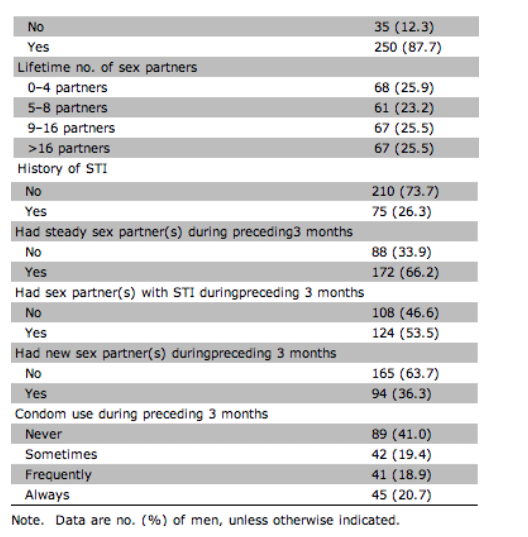
Factors associated with acquisition of HPV infection. Table 2 presents sociodemographic and behavioral characteristics associated with acquisition of any, oncogenic, and nononcogenic HPV infection in the univariate models. A reduced risk of acquisition of new infection with any type of HPV was significantly associated with having a college education or higher (HR, 0.3 [95% CI, 0.2-0.7]) and with an older age at first sexual intercourse (HR, 0.9 [95% CI, 0.8-1.0]). Current cigarette smoking was associated with increased risk of new infection with any type of HPV (HR, 2.4 [95% CI, 1.3-4.5]) and with nononcogenic HPV (HR, 2.2 [95% CI, 1.0-4.8]), compared with never having smoked cigarettes. In addition, the risk of nononcogenic HPV infection was negatively associated with having a college education or higher (HR, 0.2 [95% CI, 0.1-0.5]), compared with having a high-school education or less. Compared with men who at enrollment reported 4 or fewer lifetime sex partners, men who reported a greater lifetime number of sex partners were at higher risk of infection, for all types of HPV.
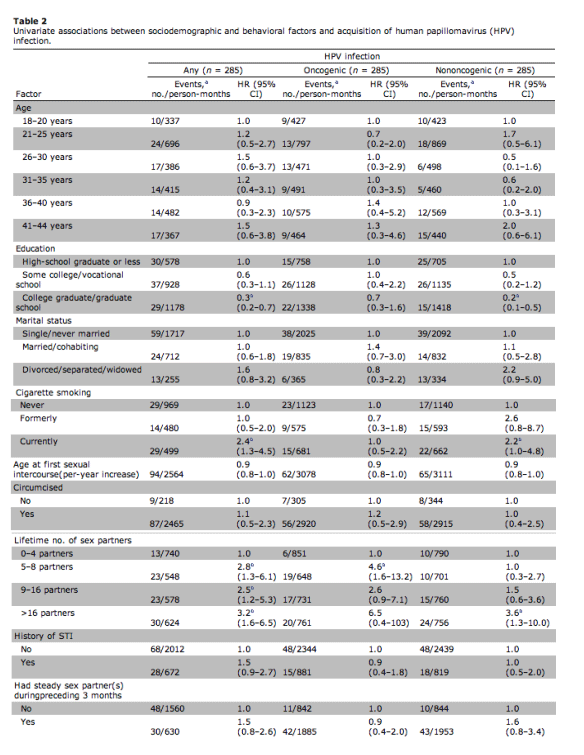
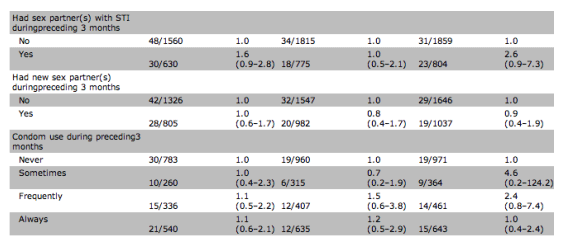
aNo. of HPV infections acquired during follow-up.
bStatistically significant (p<.05).
Table 3 presents associations detected by the adjusted multivariate models. An increased risk of all types of HPV infection was associated with an increase in lifetime number of sex partners reported at enrollment; men reporting >16 lifetime sex partners were at significantly elevated risk of infection with any type of HPV (adjusted HR [AHR], 2.8 [95% CI, 1.1-7.1]), oncogenic HPV (AHR, 9.6 [95% CI, 2.4-37.8]), and nononcogenic HPV (AHR, 3.6 [95% CI, 1.3-9.9]). In addition, an 80% reduction (AHR, 0.2 [95% CI, 0.1-0.5]) in the risk of acquisition of nononcogenic HPV infection was observed in men with a college education or higher, compared with those with a high-school_ education or less.
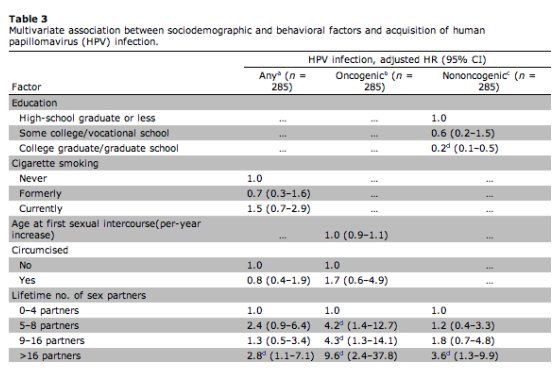
aAdjusted for cigarette smoking, circumcision, and lifetime no. of sex partners.
bAdjusted for age at first sexual intercourse, circumcision, and lifetime no. of sex partners.
cAdjusted for education and lifetime no. of sex partners.
Factors associated with clearance of HPV infection. Table 4 presents factors associated with clearance of HPV infection in the univariate analysis. A marginally significant U-shaped association was observed between age and clearance of oncogenic HPV infection, with the 26-30-year-old age group being least likely (HR, 0.3 [95% CI, 0.1-1.0]) to clear infection, compared with the 18-20-year-old age group. Clinically confirmed circumcision was significantly associated with an increased likelihood of clearance of any HPV infection (HR, 2.7 [95% CI, 1.3-5.7]) and of clearance of oncogenic HPV infection (HR, 3.2 [95% CI, 1.4-7.4]), but not with an increased likelihood of clearance of nononcogenic HPV infection.
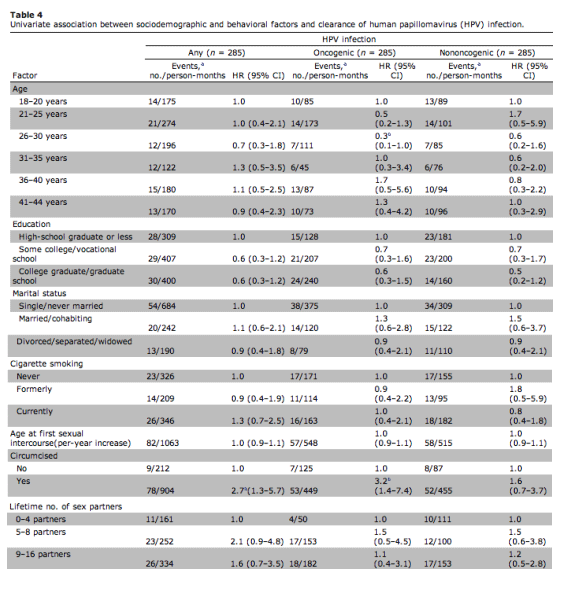
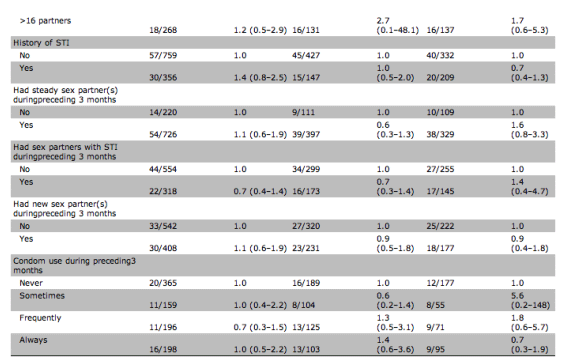
aNo. of HPV infections cleared during follow-up.
bStatistically significant (p<.05).
In the multivariate analyses presented in table 5, age was not retained as a significant explanatory variable in predicting the clearance of HPV infection. Clinically confirmed circumcision was the only factor that remained significantly associated with clearance of any HPV infection (AHR, 3.1 [95% CI, 1.2-8.2]) and with clearance of oncogenic HPV infection (AHR, 6.5 [95% CI, 2.1-19.7]). Men who reported >16 lifetime sex partners at enrollment were 4.9 times more likely (AHR, 4.9 [95% CI, 1.2-19.8]) to clear oncogenic HPV infection than were those reporting 0-4 partners.
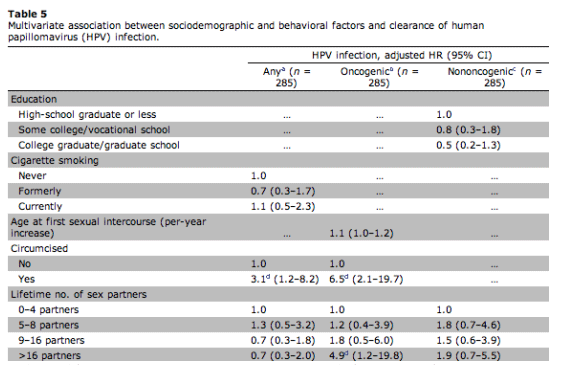
aAdjusted for cigarette smoking, circumcision, and lifetime no. of sex partners.
bAdjusted for age at first sexual intercourse, circumcision, and lifetime no. of sex partners.
cAdjusted for education and lifetime no. of sex partners.
dStatistically significant (p<.05).
Subjects and Methods
Study design and population. Between September 2003 and December 2005, the HPV Infection in Men study, a prospective study sponsored by the Arizona Disease Control Research Commission, was conducted in Tucson. Details of the study design have been described elsewhere [25]. In brief, participants were recruited via targeted community mailings and flyers placed on university and college campuses, face-to-face recruitment in classrooms and county health clinics, publicity at mass events, and radio and newspaper advertisements from September 2003 through May 2005. Men were eligible to participate if they (1) were 18-44 years old; (2) were residents of southern Arizona; (3) reported no prior diagnosis of penile or anal cancer; (4) reported no prior diagnosis of genital warts; (5) reported no current diagnosis or treatment of STI, including genital warts, genital herpes, chlamydia, gonorrhea, syphilis, nongonococcal urethritis, hepatitis B virus, hepatitis C virus, and HIV; (6) were willing to commit to 4 visits scheduled 6 months apart; and (7) had no plans to relocate during the subsequent 2 years. Participants were invited to return every 6 months and were monitored for about 18 months. At each visit, participants completed a self-administered risk-factor questionnaire and had penile and scrotal skin samples taken for HPV DNA testing. Of 377 men present at the screening visit who were eligible for the study, 337 were willing to participate and were enrolled. Of these 337 men, 35 failed to return for follow-up visits, 12 did not provide samples adequate for detection of HPV DNA, and 5 did not provide complete information on the questionnaire, leaving 285 men who completed at least 2 study visits and for whom complete HPV DNA results and risk-factor information were available for analysis.
HPV sampling and testing. To avoid interspecimen contamination, warts or lesions found on the genitals were sampled by swabbing the wart or lesion with a saline-prewetted Dacron swab before normal genital skin was sampled. Three Dacron swabs prewetted with sterile normal saline were used to sample genital skin, as described and validated elsewhere [22]. The first swab was used to sweep 360º around the coronal sulcus and then 360º around the glans penis; a second swab was used to sample the entire skin surface of each of the quadrants of the shaft of the penis; a third swab was used to sample scrotal skin. The 3 swabs were then placed in 450 μL of fixative solution (specimen-transport medium) designed to preserve DNA and were delivered to the laboratory. All HPV samples were stored at -70ºC until polymerase chain reaction (PCR) analyses and genotyping were conducted.
Testing of the swabbed cellular material for the presence of HPV was conducted by PCR for amplification of a fragment of the L1 gene [33]. Extraction of HPV DNA was performed by use of a QIAamp DNA Mini Kit (Qiagen), according to the manufacturer's instructions. DNA was eluted at 60ºC with 50 μL of Tris-EDTA buffer (pH 7.5) at 10 mmol/L and was stored at -20ºC until used. Samples were tested for the presence of HPV DNA by use of the PGMY09/11 L1 consensus primer system [33]. The reverse-line-blot method was used for HPV genotyping of all samples (Roche Molecular Diagnostics) [34]. This detection method uses the HPV L1 consensus PCR products labeled with biotin to detect 37 types of HPV and 2 concentrations of the β-globin control probe (Roche Molecular Diagnostics). Only samples that were β-globin positive by the genotyping assay (99% at baseline) were deemed adequate and were included in this analysis. Samples that amplified HPV by PCR but did not hybridize with a specific HPV type during genotyping (e.g., unclassified infections) were classified as HPV negative. HPV 16, 18, 31, 33, 35, 39, 45, 51, 52, 56, 58, 59, and 66 were classified as oncogenic types, and HPV 6, 11, 26, 40, 42, 53-55, 61, 62, 64, 67-73, 81-84, IS39, and CP6108 were classified as nononcogenic types [35].
Statistical analysis. To evaluate the association between risk factors and acquisition and clearance of HPV infection, we used a continuous-time 2-state Markov model. The 2 states in the Markov model were defined as the HPV-negative state and the HPV-positive state, throughout the analyses. All possible transitions between the 2 states are shown in figure 1. Acquisition of infection refers to one or multiple HPV types, by each of the 3 HPV groups (defined as "any," "oncogenic," and "nononcogenic"), that had not been detected during the previous visit; clearance of infection is defined as the absence of one or multiple HPV types that had been present during the previous visit. Infection with one or multiple oncogenic HPV types, as well as mixed infection with both oncogenic and nononcogenic HPV types, were classified as oncogenic infection, and single or multiple infection with only nononcogenic HPV types was classified as nononcogenic infection. Multiple HPV types detected or cleared during a visit were treated as a single episode. The rate of acquisition (incidence rate) was modeled as the rate of transition from an HPV-negative state to an HPV-positive state; the rate of clearance was modeled as the rate of transition in the opposite direction. The effects that risk factors have on acquisition or clearance were modeled by relating the risk factors to the rate of acquisition or clearance, on a logarithm scale. To determine its influence on the rate of acquisition and clearance, each potential determinant was screened in the univariate models, using an a level of 0.10, and factors identified as being significant in the univariate models were further selected, by use of the likelihood-ratio test and a backward-selection method, in the multivariate models.
A total of 285 participants were included in the analysis, contributing 963 person-visits and 689 pairs of observations. We examined the risk of acquisition and clearance in relation to basic sociodemographic characteristics, such as age, marital status, and education; time-independent lifestyle and behavioral factors, such as cigarette smoking, circumcision, age at first sexual intercourse, and lifetime number of sex partners reported at enrollment; and time-dependent factors, such as diagnosis of STI, steady sex partners, new sex partners, and condom use during the preceding 3 months. Hazard ratios (HRs) and 95% confidence intervals (CIs) were obtained from the models, as measures of association.
|
|
| |
| |
|
|
|